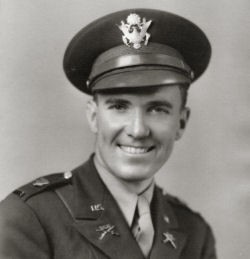|
Awards and Decorations
Battles
Medals
Recommendation for Presidential Unit Citation (originals)
358th Infantry Typed History from 9 July - 31 July 1944

|
Recommendation for Presidential Unit Citation
|
HEADQUARTERS 358TH INFANTRY
APO NUMBER 90
26 August 1944
SUBJECT: Recommendation for Battle Citation
TO: Commanding General, Third United States Army
THRU: Commanding General, 90th Infantry Division
1. Forwarded herewith for consideration of Battle Citation is the history of the part that the Third Battalion, 358th Infantry played in the Battle of the Foret De Mont Castre.
2. It is believed that the break through of the forest by the Third Battalion, 358th Infantry on 10 July 1944, was the factor which undermined the German resistance and caused it to crumble along the rest of the Division Front. Major General Landrum, Commanding the 90th Division, stated this fact to the assembled Regimental Staff and Battalion Commanders before he left the Division.
3. Since it was through the outstanding leadership of the officers and the devotion to duty of the men that the campaign was a success, it is felt by this Command that the Third Battalion should be justly rewarded by a citation.
CHRISTIAN H. CLARKE JR
Lt. Col., Infantry
Commanding
INCL: Three (3)
1 - History of the Battle
2 - Sketches
|
|
THIRD BATTALION, 358TH INFANTRY
BATTLE OF THE FORET DE MONT CASTRE
For approximately three days, the 8th, 9th, and 10th of July 1944, the 90th Infantry Division was engaged in The Battle of the Foret De Mont Castre and did not succeed in penetrating the forest. During the battle, Third Battalion, 359th Infantry, was on the right flank of the Third Battalion, 358th Infantry and the Second Battalion, 359th Infantry, was attached over to the 358th Infantry and was on the left flank of the Third Battalion, 358th Infantry.
On the afternoon of 10 July 1944, The Third Battalion, 358th Infantry which was occupying a defensive position of the northern edge of the Foret De Mont Castre (See overlay #1), was ordered to attack at 1400 to the south-west of its sector.
The strength of the Battalion at the start of this battle was as follows:
| Company I |
5 Officers |
143 Enlisted Men |
| Company K |
5 Officers |
152 Enlisted Men |
| Company L |
3 Officers |
139 Enlisted Men |
| Company M |
4 Officers |
129 Enlisted Men |
At 1400, the Battalion crossed its LD (see overlay #1), and advanced in its sector without artillery preparation. Company I was on the left guiding on the fire break, Company L on the right, and Company K in right rear reserve behind Company L. Lt. Col. Bealke and his command group consisting of Capt. John W. Marsh, the heavy weapons company commander, and seven enlisted men moved behind the left platoon of Company L at a distance of 100 to 200 yards.
The Battalion advanced in its sector though the woods for approximately 600 yards before striking any enemy resistance. The terrain of the Third Battalion sector was at first a hillside gently sloping from north-east to south-west. The landscape was covered with a dense undergrowth, taller than a mans head, choked with matted plants and tangled vines, almost jungle-like in appearance. Visibility was limited from five to twenty-five yards. No roads existed, but one trail ran down the forest parallel to the Battalion direction of advance. Company I, the left assault company, guided on this trail.
The two assault companies, I and L were each advancing in formation of two platoons as skirmishers and one platoon in column to the center rear. In this manner they beat out the thicket, but contact was extremely difficult as was maintenance of direction due to the dense undergrowth.
-1-
|
|
At approximately 1500, Lt. Col. Bealke halted the Battalion in order to regain contact and find out the exact location of the Battalion. At this time the I Company platoons were in contact with each other and the left platoon of Company L was in contact with the right platoon of Company I, but the two remaining rifle platoons and the weapons platoon of Company L were back to the right rear and out of contact. Company K was somewhere to the rear behind Company L and also out of contact with the rest of the Battalion except by SCR 300 radio.
Lt. Col. Bealke, having halted Company I and the left platoon of Company L, ordered these units to regain contact and then requested the artillery by telephone to fire a purple smoke shell on a concentration number which was believed to be close by. He then adjusted the fire until it was immediately in front of the Battalion and then asked the artillery to give him the closest coordinates possible of the last round so that he could locate the position of the Battalion. Since visibility during the entire advance had been but between five and twenty-five yards, it was only by this means that the Battalion Commander found his exact location. He found his location to be at Point "A" (Sketch A).
The companies in the meantime having regained contact, Lt. Col. Bealke ordered the advance continued. Shortly thereafter all units ran into fierce and determined resistance. The Germans were paratroopers, practically invisible in camouflage clothing. They were young, strong, fanatically determined and skilled in individual combat. They threw dozens of hand grenades and fired machine guns and rifles from trees, from spider trap holes, from dug-in positions in the tangled positions in the undergrowth, and from behind rocks. A prisoner of war later revealed that their orders were to withhold fire until our troops approached to within 10 to 15 yards. They obeyed to the letter. During this action, Company I ran into a German position located behind a pile of rocks 25 feet high. The company was proceeding through a thick tangle of brush and had a visibility of about five to fifteen yards. Suddenly about ten hand grenades were hurled over the brush and landed in the vicinity of the two assault platoons, causing heavy casualties. Company I's light machine gun section was practically wiped out by this attack and the Company Commander, Lt. Miller, and one other man seized one gun and continued the advance. At this time, fire from several German machine guns sprayed through the brush, pinned the entire company to the ground. Even then, because of the dense undergrowth, the platoon scouts could not see the enemy who could not have been more than twenty yards from them.
Pfc William L Smiley, Company I, alone and on his own initiative crawled forward 20 yards through the undergrowth, scaled the rocky hill and fired several shots over the hill before he was mortally wounded. Pfc Theodore Wagner of Company I, then followed Smiley's example, worked his way forward 20 yards through the undergrowth, scaled the rocky hill and threw several hand grenades over it.
-2-
|
|
The machine gun firing and hand grenade throwing from behind the hill thereupon ceased. Pfc Wagner returned to his platoon and grabbed a prisoner whom someone in the meantime had captured, held the prisoner across his chest to cover him from enemy fire and ordered the prisoner in what little German he knew to call out to his comrades behind the hill and order them to surrender. He walked around the hill and eight Germans, three of who were wounded surrendered to him. Nine other dead Germans were also found. Company I by use of this rocky hill now had an observation post from which they could see for the first time for some distance in every direction and could see plainly the fields to the south of the forest.
At this time Company L had also run into heavy machine gun fire and hand grenades, and was viciously engaged at close range with determined enemy. 1st Lt. George M. Bird was wounded at this time when he went forward alone and killed two Germans and routed several others who were holding up the advance of Company L. In spite of his leg wound he reorganized his company under fire, and ordered it to continue its advance before he was evacuated.
At approximately 1600 or about 10 minutes after Lt. Bird had been evacuated and also at approximately the same time Company I was seizing the small rocky hill, Lt. Col. Bealke and his command group, which were abut 100 yards behind the left platoon of Company L, at Point B (Sketch A) were viciously attacked by an estimated squad of Germans, who came from the west through the thicket behind the assault platoon of Company L and threw hand grenades and fired machine guns at the command group. The enemy were beaten off by small arms fire of the command group and a small platoon of Company L which had come down through the thicket and run into the command group, when suddenly the Germans attacked the command group again from the west side and the rear this time with what much have been a rifle platoon. (See sketch)
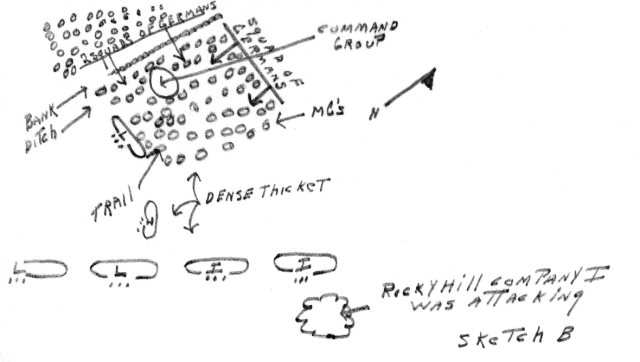
-3-
|
|
The group attacking from the west threw fifteen to twenty grenades, principally of the concussion type and moved into the bank behind which the command group was somewhat sheltered from small arms fire from the west. The German group attacking from the north raked the thicket with the fire of several machine guns.
The command group was immediately involved in a close range fire-fight which might have been disastrous had not the platoon of Company L under Lt. Sanders, which had just passed by, returned and rushed the enemy capturing six German parachutists and killing several. The Germans to the rear were all killed or captured, and of the ones to the west, all were killed or hastily withdrew to the west.
Lt. Col. Bealke then again ordered the Battalion to halt, regain contact, and placed the companies for an all around defense by moving Company K forward from the rear. The Germans were at this time shelling the Battalion heavily from Hill X (see sketch a), with mortar fire and occasionally with artillery fire which had started about the time Company I took the small hill and just after the command group had beaten off the counter-attack from the rear.
While this reorganization was going on, the Battalion Executive Officer and adjutant guided down a platoon of four tanks followed by all the Battalion litterbearers and ammunition vehicles which followed the road which the tanks had crashed through the thicket. At this time approximately fifteen wounded were evacuated by litter as well as many walking wounded. Wire communications which had gone out during the counter-attack from the rear and which the wire men could not re-establish because of the counter-attack, were re-established.
At approximately 1800, Lt. Col. Bealke ordered the Battalion to again resume the attack. The plan of attack was to pass Company K with the tank platoon attached, through Company L and to break out into the open field south of the forest in the Third Battalion zone. The Battalion was still receiving heavy mortar and artillery fire from Hill X (see sketch A) which was in the zone of action of the 359th Infantry on the right of the Battalion. Company L was therefore placed so as to return the fire coming from Hill X and to protect the right flank of the Battalion in the thicket. Company I similarly protected the left flank of the Battalion, while Company K went forward. The friendly unit on the right and left were at this time at least 500 yards to the rear of the Third Battalion advance and large gaps existed in the forest between Battalions. Infiltrations of large units of Germans was therefore quite possible and probable as the battalion had already experienced.
The attack of Company K succeeded initially, supported by three tanks which proceeded the advance by ten or fifteen yards. Tanks R and S (Sketch A) were knocked out immediately by a self propelled gun firing from an orchard 400 yards to the south. Tank Q was stuck in a marshy spot in the open field (sketch A) and was immobilized.
-4-
|
|
Notwithstanding the loss of the tanks, Company K went forward under heavy fire, particularly from German dug-in positions on their right and left in the forest.
At 2000, Lt. Hilton of Company K, unable to advance father, and finding his position untenable because of the German fire coming from three sides of his company, which caused heavy casualties, went back to the rear to ask permission of the Battalion Commander to withdraw his company. He was severely wounded enroute back and never reached the forest. A second Company K officer, Lt. Hansen, then went for orders. He never arrived, although he was subsequently found and evacuated after the next day's advance out of the forest. He reported that he had been treated by German Aid Men but was left to be evacuated by us.
The battle went on with terrific intensity until dusk. In the meantime Company B, 358th Infantry, was attached to the Third Battalion and was placed on the right flank to assist Company L in holding off the Germans from Hill X. Because of the resistance on either flank Company I and L could not go forward or the Battalion would have been surrounded from the rear. The 3rd Battalion, 359th Infantry on the right, and the 2nd Battalion, 359th Infantry on the left were now approximately 600 yards to the rear. They did not draw abreast until the following day. During this time, Capt. John W. Marsh, Company M Commander was killed by a mortar shell near point B, while helping to reorganize Company L.
At dusk, Company K, was forced to withdraw back to the forest and the Battalion Commander placed the companies in a square formation. This constituted an all around defense for the night, I.E.
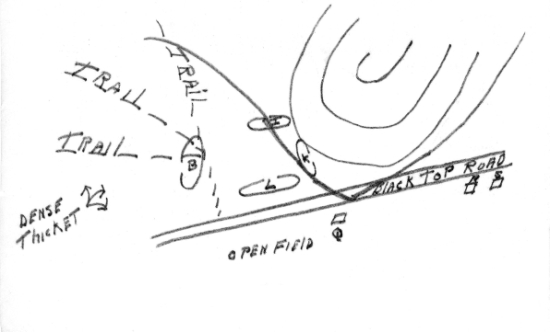
-5-
|
|
From dusk until 0430, 10-11 July 1944, the Battalion litterbearers and entire ammunition and pioneer platoon worked down the trail, carrying forward rations and water and carrying back casualties. At 0630 more casualties were found, including a tank man, who although severely wounded, had crawled 800 yards back to the Battalion position.
All together, some 85 wounded casualties were evacuated from this particular battle to the Battalion Aid Station, and many wounded men of Company K were evacuated by the Germans after the Company had withdrawn. The strengths of the companies of the Battalion at dusk the night 10 July 1944 were as follows:
STRENGTH |
NUMBER OF CASUALTIES |
| Company I |
2 Officers |
64 Enlisted Men |
3 Officers |
79 Enlisted Men |
| Company K |
1 |
31 |
4 |
121 |
| Company L |
1 |
48 |
2 |
91 |
| Company M |
2 |
77 |
2 |
52 |
On the subsequent day, 11 July 1944, the Battalion organized as one Battle Group under the command of Lt. Miller, shifted to the right and attacked at 2100 the positions which previously enfiladed them. They ran the enemy back in a disorganized retreat to the town of Lastelle. They gained point F in two hours of fighting but withdrew 400 yards to make contact with First Battalion, 359th Infantry, who had been committed on the left of Third Battalion, 359th Infantry.
Together with this Battalion, the Third Battalion, 358th Infantry advanced at 2400 to the near edge of the town of Lastelle, gaining the position without opposition about 0200.
On the third day, 12 July 1944, the German resistance was found to be broken and the Germans had withdrawn. The Battalion now consisting of but four officers and one hundred and twenty six men in the three rifle companies was able to advance some 3000 yards to the vicinity of La Valaisserie with only slight resistance from a few enemy guns and snipers.
In the subsequent evacuation of the dead from Foret De Mont Castre that took place on the 11th and 12th of July, over fifty dead of the Third Battalion were evacuated from the forest and fields by the Third Battalion Evacuation Squads. Other units were also working in the area so that the total dead in the area was considerably higher. The German dead were about twice as numerous on this battle field than our own according to Lt. August Ackel, Regimental Graves Registration Officer, although the Germans had evacuated many of their dead on the night of 9 July 1944.
CHRISTIAN H. CLARKE JR.
Lt. Col., Infantry
Commanding
-6-
|
|
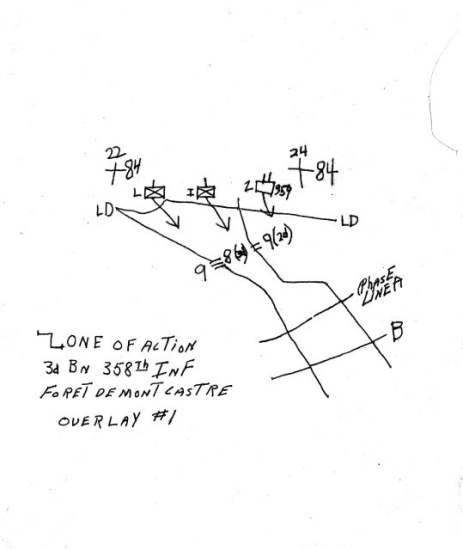
-7-
|
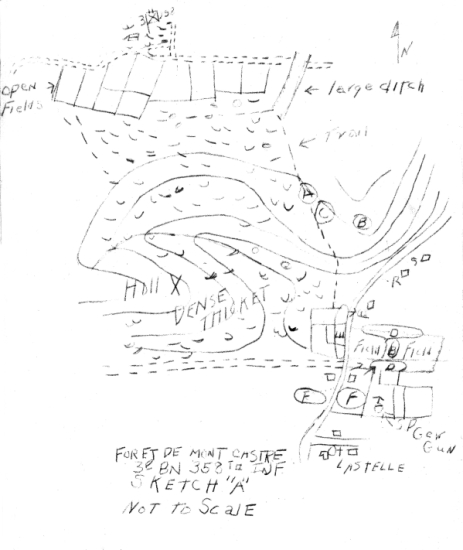
-8- |
|
